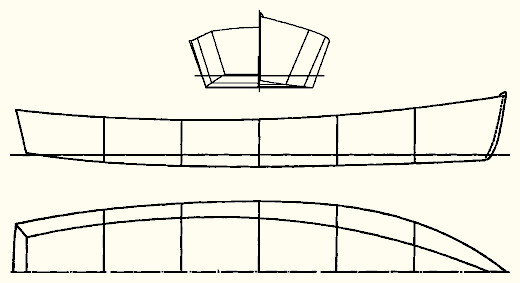

This month there comes over the horizon a useful, safe, and very practical kind of flat bottom skiff. The design shows a boat 14 feet 10 inches in overall length, 14 feet on the water line, 4 feet 4 inches in breadth, and 4 1/2 inches in draft; the latter being the draft of the hull with two average weight men aboard. The completed boat without any one aboard and without the outboard motor will weigh approximately 190 pounds, provided, of course, the boat is built of the materials specified in the plans. So, you see, there is ample displacement provided for something more than the weight of two men and an outboard motor of modest power. The designed displacement of the little (or should I say big) skiff is very close to 550 pounds. The freeboard at the stem is 1 foot 10 inches, the least freeboard is 13 inches, and the freeboard at the stem is 16 1/2 inches. Therefore, even if carrying three average weight men, the boat will still remain buoyant, and the least freeboard will approximate a height of 12 inches..

The deck plan of C. G. Junior shows two thwarts and the stern sheets. These are placed well down in the boat and it will be noticed there are no seating accommodations in the bow. It will also be noticed that there is a watertight, or secondary stern in the boat. In rough water, especially if the boat is not underway, water is all too likely to slop into the boat through the cutaway opening required for the attachment of the motor. If this happens in C. G. Junior only the stern compartment will be filled; a much better situation than the same amount of water slopping around in the bilge and increasing every time a wave climbs over the notch in the stern. And speaking of water in the bilge every small open boat should be made to carry a first class wooden boat scoop. Tin cans and glass jars are very poor things to use for bailing.

The drawing of the lines shows a form having a shipshape sheer, slightly curving stem, modest overhang at both ends, and sufficient flare in the topsides to give reserve bouyancy above the water line. The topside flare also assures dryness in choppy water, a feature which should be looked for in every skiff. The fore-and-aft sweep of the bottom is designed to provide speeds up to 8 miles an hour without excessive settling by the stern, and furthermore is of a form which will permit very low speeds for trolling or working among closely anchored boats, navigating narrow waterways, and safely maneuvering when making a landing alongside floats, docks, and other vessels. We have also borne in mind the matter of rowing as a means of propulsion. It is comforting to know that the skiff will behave well under the urge of oars.

In extenuation of the thousands of people that rent rowing and outboard skiffs from the average rental setups which cluster wherever water reaches a convenient highway, and a prospect of angling for fish beckons, I must say,that on the whole the boats put into the hands of inexperienced (or for that matter, experienced) men, women and children, are not always adequate. So it may not be amiss to suggest a more able and larger outboard motor skiff than we customarily see tied up in rows along floats, on the ends of pulley lines, hauled up on the beaches, and in use generally for both profit and pleasure. To follow up the suggestion, here are the designs of a wholesome, able and easily propelled flat bottom skiff. One that can take a bit of a beating and not too easily dump its passengers into the sea.